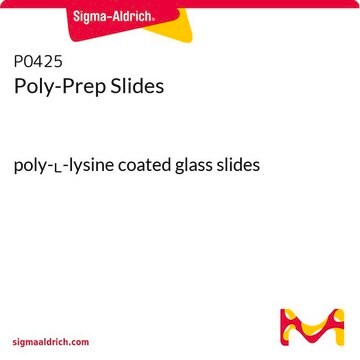추천 제품
product name
Poly-L-lysine solution, mol wt 150,000-300,000, 0.01%, sterile-filtered, BioReagent, suitable for cell culture
무균
sterile-filtered
제품 라인
BioReagent
형태
solution
분자량
150,000-300,000
포장
pkg of 50 mL
농도
0.01%
기술
cell culture | mammalian: suitable
불순물
endotoxin, tested
solubility
water: soluble
배송 상태
ambient
저장 온도
2-8°C
InChI
1S/C18H38N6O4/c19-10-4-1-7-13(22)16(25)23-14(8-2-5-11-20)17(26)24-15(18(27)28)9-3-6-12-21/h13-15H,1-12,19-22H2,(H,23,25)(H,24,26)(H,27,28)/t13-,14-,15-/m0/s1
InChI key
WBSCNDJQPKSPII-KKUMJFAQSA-N
유사한 제품을 찾으십니까? 방문 제품 비교 안내
일반 설명
애플리케이션
- In coating 96-well plates for cell attachment in testing respiratory burst activity.
- In coating glass cover slips for immunofluorescent labeling of intracellular structures.
- For pretreating 6-well plate in myosatellite cell isolation protocol.
- In coating coverslips for cell adhesion in E14 neuron culture to study possible mechanism of action of circRNA_01477 in neurons.
생화학적/생리학적 작용
성분
제조 메모
관련 제품
호환 제품
Storage Class Code
12 - Non Combustible Liquids
WGK
WGK 2
Flash Point (°F)
Not applicable
Flash Point (°C)
Not applicable
시험 성적서(COA)
제품의 로트/배치 번호를 입력하여 시험 성적서(COA)을 검색하십시오. 로트 및 배치 번호는 제품 라벨에 있는 ‘로트’ 또는 ‘배치’라는 용어 뒤에서 찾을 수 있습니다.
이미 열람한 고객
문서
Poly-Lysine enhances cell binding with positively-charged surface ions, optimizing electrostatic interaction on culture surfaces for increased cell attachment.
3D cell culture overview. Learn about 2D vs 3D cell culture, advantages of 3D cell culture, and techniques available to develop 3D cell models
Cancer stem cell media, spheroid plates and cancer stem cell markers to culture and characterize CSC populations.
프로토콜
Adhere cells to solid substrates using poly-lysine, which enhances electrostatic interaction between negatively charged ions of the cell membrane and the culture surface.
자사의 과학자팀은 생명 과학, 재료 과학, 화학 합성, 크로마토그래피, 분석 및 기타 많은 영역을 포함한 모든 과학 분야에 경험이 있습니다..
고객지원팀으로 연락바랍니다.







